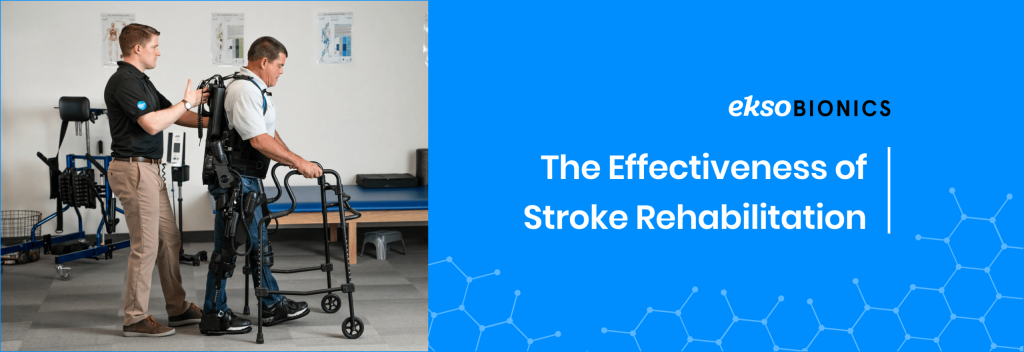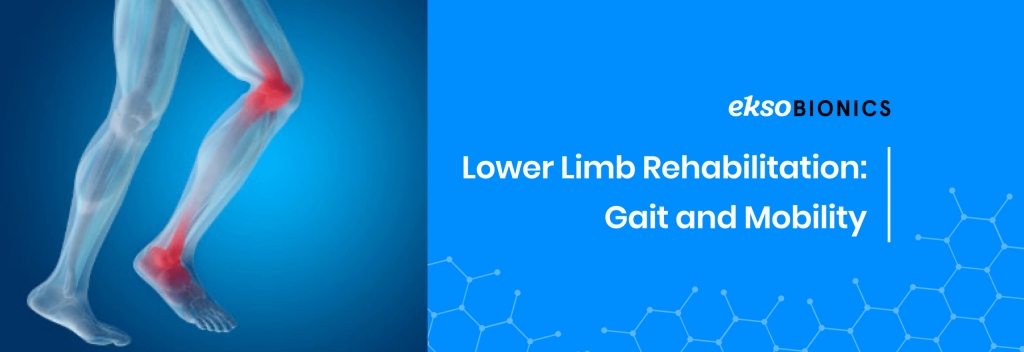Stroke, as defined by the World Health Organization, is an accident to the brain that has “rapidly developing clinical signs of focal or global disturbance to cerebral function, with symptoms lasting 24 hours or longer, or leading to death, with no apparent cause other than of vascular origin and includes cerebral infarction, intracerebral hemorrhage, and subarachnoid hemorrhage”. [1]
Stroke is ranked as the 5th leading cause of death worldwide and the leading cause of disability, with a new stroke happening every 40 seconds. [2] In the United States alone, approximately 800,000 people experience a stroke each year, and about two-thirds of this population require rehabilitation to get back to their lives. With the growing need for stroke rehabilitation each year, we aim to break down what stroke rehabilitation entails and highlight some of the modern physical therapy treatment techniques you can incorporate into your stroke rehabilitation program as a physical therapist.
The Effectiveness of Stroke Rehabilitation

Stroke rehabilitation is a program of different therapy techniques put together with the aim of helping a patient relearn lost skills, optimizing how a patient functions, and increasing their level of independence in order to achieve the best quality of life.
Effective stroke rehabilitation requires you to work closely with your patients, altering the different types of therapy depending on their needs and changing the intensity and time of their program based on their progress. Successful stroke rehabilitation depends on:
- Physical factors like the severity of the stroke.
- Emotional status of the patient, for example, motivation, resilience, persistence, grit, consistency, etc.
- Social support, for example, from family and friends.
- Curative elements like early rehabilitation and the skills of the stroke rehabilitation team.
These factors have been practically proven to impact the success of rehabilitation in real-world scenarios. In a 2017 randomized control trial, researchers concluded that rehabilitation combined with early supported discharge (ESD) “seems to reduce death and institutional care and to improve patients’ chances of living at home 5 years after stroke compared to traditional stroke care. There is a trend toward an improved functional outcome in the ESD group.” [3]
One of the important elements of successful rehabilitation that has been proven in neurorehabilitation is focused repetitive practice. It’s the same element we use when learning new skills like writing, playing a musical instrument, or sports. Research shows that functions located in areas of damage are normally moved to other regions of the brain, and carefully directed practice can help in the rewiring of brain circuits in the new areas. [4]
According to research, early rehabilitation is associated with better outcomes, irrespective of the severity of the stroke. Thus, physical therapy should be offered early in the recovery process. In addition, if rehabilitation happens in a different location from acute care, the transition should be seamless. A review by Harutoshi Sakakima et al. alludes to physical exercise being a prototypical precondition stimulus that provides brain protection effects. [5]
There are many treatment methods that can be incorporated into a stroke rehabilitation program, but for this article, we will specifically focus on physical therapy techniques that aid in upper and lower extremity function recovery.
Physical Therapy Treatment Techniques

There are many treatment techniques that can be used in upper limb and lower limb rehabilitation. Therefore, these ideas are not an exhaustive list of what’s available.
Lower Limb Rehabilitation: Gait and Mobility

Gait recovery is a primary goal in any rehabilitation program for patients recovering from stroke and can be achieved using the following interventions:
- Body Weight Supported Gait Training: This training method helps a patient control their weight, balance, and posture by using a harness that is mounted from a metal frame or ceiling. It can take place over a treadmill or over the ground. When using a treadmill, the patient is secured using a harness for fall prevention and then set up over a treadmill. Body weight-supported treadmill training provides more control over the ambulation speed, environment, and allows therapists to offer cues for proper gait dynamics.
Therapists can control the effort required by patients during training by weighting or unweighting the patient using the suspension system. Unweighted training reduces the amount of weight borne by the patient and makes the patient feel lighter. This, in effect, makes the patient expend less effort during the training sessions.
Body weight can, however, be added back during training depending on the patient’s progress and abilities. Therapists can also help with stance with swing phases of gait, posture, knee control, heel strike, and limb advancement. Research reports that body weight-supported treadmill training can help improve motor function and balance. Additionally, it helps enhance gait quality compared to traditional gait training methods. [6]
- Electromechanical Assisted: Electromechanical-assisted gait training is commonly used as a supplementary training technique for overground training. It’s great for completely immobilized patients as it helps them intensely practice complex gait cycles without overexertion on the therapists part. Robotic exoskeletons are popular in this category as they help increase movement during training while reducing therapists’ burden. They require less manpower for the same mechanical therapy that traditional rehabilitation methods use. Since the exoskeleton does most of the work, the therapist only needs to set the patient up in the device and supervise them. [7]
Apart from increased repetition, exoskeletons can help patients relearn the proper walking technique from the start of the rehabilitation. They also offer other benefits like sensory feedback, weight support, and real-time control and monitoring features. Robotic exoskeletons are also advantageous in helping patients increase their range of motion. [8]
EskoNR is a leading robotic exoskeleton in use in rehabilitation clinics around the world. It is cleared by the Food and Drug Administration for rehabilitation and offers unique features to help patients learn to walk again. It provides different gait training modes that support the knees, ankles, hips, and torso and helps the patient maintain an upright posture. You can use it in the preGait mode or walking mode depending on the recovery level of your patient. The preGait mode contains activities that help prepare patients to take their first steps, like balancing and midline orientation. As a patient progresses in their recovery, the EksoNR reduces the support offered, allowing for more control and stability, eventually leading them to walk without the device.
- Rhythm Cueing: Rhythm cueing involves the synchronization of movement to a uniform sound. Rhythmic cues are used to guide movement and influence motor execution, but they don’t have to be strictly rhythmic. According to research, rhythmic cueing can help improve timing in motor tasks that have complex timing and in conditions that affect how an individual perceives time with regard to movement. Having external rhythm can also help by supporting the mechanisms of the brain that are associated with keeping time. [9]
Successful gait training with rhythmic cues requires auditory inputs from different parts of the motor control system like the cerebellum, cerebral cortex, nervous system, and brainstem. Additionally, to achieve success, the gait must be well linked with the acoustic rhythm, and the speed of the metronome must be right. [10]
- Overground walking: Overground walking, also known as overground gait training, involves observing a patient’s walking pattern on a solid surface while cueing them to perform different activities that can help improve their gait. This is a simple and easy technique to incorporate into your rehabilitation program as it doesn’t require complex technology and can be done in a variety of locations.
- Orthotics: Orthotics deals with the design of custom artificial braces and splinters that can be used to correct, support, or stabilize a body structure. One common type of orthosis used in lower extremity rehabilitation is an ankle foot orthosis. KNGF Clinical Guidelines recommend it for individuals whose mobility is affected by drop foot during the swing phase of walking. [11]
- Functional Electrical Stimulation (FES): This is a rehabilitation technique that uses low-energy pulses to activate weak muscles and nerves. Functional electrical stimulation has been in use since 1960. It relies on electrodes to stimulate the relaxation and contraction of muscle groups. One important and interesting thing to note is that it’s the nerves and not the muscles that are stimulated, as they have lower current requirements compared to muscles. Some of the factors that affect how electrical stimulation works include the size of the surrounding tissue and the distance between the nerve fiber and electrode.
FES application in rehabilitation settings is important because it helps promote motor recovery by providing visual and sensory feedback. It also helps avoid disuse atrophy, a common stroke complication resulting in muscle fiber changes. FES can help by correcting the muscle fiber changes by changing the type II glycolytic fibers back to type I oxidative skeletal muscle fibers.
- Balance Training: A stroke can cause weakness in one side of the body, leading to balance impairment. Hence the need for balance training and weight-shifting exercises. Researchers reviewed literature published between January 2006 and February 2010 and concluded that balance training is an effective technique for rehabilitating patients with stroke. [12]
- Stair Training: Stair training is a great training method for mobility rehabilitation as it helps patients recover their range of motion in slopped environments. In a 2017 study investigating the effects of stair task training on walking ability in stroke patients, thirty-six patients with stroke were selected randomly and divided into two groups: the experimental group and the control group. The study reported that the gait training group that used the 10-cm high stairs showed the biggest improvement in balance and muscle activities compared to the other group. These results conclusively showed that stair training is a viable rehabilitation technique in clinical environments and can be used to improve patients’ walking ability. [13]
In a 2021 randomized controlled study investigating the efficacy of lateral stair walking training in patients with chronic stroke, it was revealed that lateral stair walking improves hip muscle strength and gait in patients. Thus, stair walking can be added to rehabilitation programs to aid gait and balance improvement. [14]
- Strength Training: Strength training is a versatile technique that can be used to rehabilitate both the upper and lower extremities. While there isn’t a specific strength training approach for lower extremity rehabilitation, progressive exercise has been shown to help improve muscle strength and is recommended by Australian Stroke Foundation guidelines (2017) and the AHA guidelines (2010). [15] Although resistance training effectively improves strength, there is limited evidence supporting its influence on walking parameters. [15] [16] Common strength training exercises used in physical therapy target the quadriceps and hamstrings.
Upper Limb Rehabilitation Practices

- Bilateral Arm Training: Bilateral arm training is a form of intensive training that involves performing movement patterns or activities with both hands at the same time but independently of one another. These movements or activities may also be cyclic. This method was created in response to CIMT’s (Constraint Induced Movement Therapy) known drawbacks, which include its inability to allow for the practice of bilateral skills, especially those involved in functional activities that are by their very nature bimanual. Both bilateral and unilateral training have the same positive effects. The severity of upper limb paresis and the timing of the intervention following the stroke, however, may affect the outcome of the intervention.
- Constraint-Induced Movement Therapy: The goal of constraint-induced movement therapy (CIMT) is to encourage patients with hemiplegic stroke to practice moving their affected limb while restraining the unaffected limb.
- Robot-Assisted Arm Training: Robot-centered training involves the use of mechanical devices to offer active, passive, and resistive limb movement. This method is great for extended treatment periods and can be customized to the needs of the patient by using their movement as feedback. Though there is limited evidence on the use of robot-assisted arm movement, it can be combined with other conventional therapy methods to provide better rehabilitation outcomes. According to a 2018 study, “People who receive electromechanical and robot-assisted arm training after stroke might improve their activities of daily living, arm function, and arm muscle strength.” [17]
- Strength Training: Strength training is designed to increase muscle strength and endurance. According to research, strength training has the ability to improve strength and function in the upper extremity without increasing pain in patients with stroke. [18] However, the intensity of strength training doesn’t affect outcomes, as shown in a recent study. Common strength training exercises that are commonly used in upper limb training include bridges, tricep dips, weight-bearing leans, tabletop lateral pushing exercises, tabletop forward pushing exercises, and bicep curls. For effective strength training, all the training exercises should be adjusted to the level of the patient’s ability.
Conclusion

All these training methods can be incorporated into a rehabilitation program in different combinations and at different times. The key to maximizing their effectiveness is tailoring them to your patient’s individual needs and abilities. When introduced early, they can help improve results and boost the success rate of your program. Above all, intensive practice is an important factor irrespective of the technique you choose.
Ekso Bionics is a leading medical exoskeleton manufacturer on a mission to help patients learn how to walk again. EksoNR was one of the first FDA-approved medical exoskeletons for stroke rehabilitation. It is the exoskeleton of choice for many physical therapists and is available in rehabilitation clinics around the world. If you would like to procure an exoskeleton for your clinic, contact us by clicking here.
References:
- Stroke in the 21st Century: A Snapshot of the Burden, Epidemiology, and Quality of Life – PMC https://www.ncbi.nlm.nih.gov/pmc/articles/PMC6288566/#B1
- Acute Stroke – StatPearls – NCBI Bookshelf https://www.ncbi.nlm.nih.gov/books/NBK535369/
- Stroke unit care combined with early supported discharge improves 5-year outcome: a randomized controlled trial https://pubmed.ncbi.nlm.nih.gov/21474806/
- Post-Stroke Rehabilitation Fact Sheet | National Institute of Neurological Disorders and Stroke https://www.ninds.nih.gov/post-stroke-rehabilitation-fact-sheet
- Endogenous neuroprotective potential due to preconditioning exercise in stroke – PMC https://www.ncbi.nlm.nih.gov/pmc/articles/PMC6992848/#!po=18.4211
- The Effect of Body Weight Support Treadmill Training on Gait Recovery, Proximal Lower Limb Motor Pattern, and Balance in Patients with Subacute Stroke – PMC https://www.ncbi.nlm.nih.gov/pmc/articles/PMC4663281/
- Lower-Limb Robotic Rehabilitation: Literature Review and Challenges https://www.hindawi.com/journals/jr/2011/759764/
- Robot-aided assessment of lower extremity functions: a review | Journal of NeuroEngineering and Rehabilitation | Full Text https://jneuroengrehab.biomedcentral.com/articles/10.1186/s12984-016-0180-3
- Immediate Effects of Rhythmic Auditory Stimulation with Tempo Changes on Gait in Stroke Patients – PMC https://www.ncbi.nlm.nih.gov/pmc/articles/PMC3996403/
- Walking to the beat of different drums: Practical implications for the use of acoustic rhythms in gait rehabilitation – ScienceDirect https://www.sciencedirect.com/science/article/pii/S0966636211000786
- What Is the Evidence for Physical Therapy Poststroke? A Systematic Review and Meta-Analysis – PMC https://www.ncbi.nlm.nih.gov/pmc/articles/PMC3913786/
- The effect of balance training on balance performance in individuals poststroke: a systematic review https://pubmed.ncbi.nlm.nih.gov/20716987/
- Effects of stair task training on walking ability in stroke patients – PMC